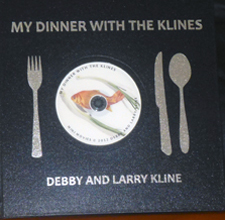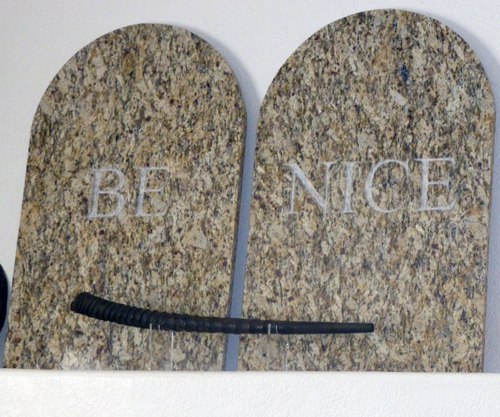
By Donald H. Harrison


ESCONDIDO, California — When artists Larry and Debby Kline go out to casual dinners, they can’t help playing with the detritus of restaurant meals — the sugar and saccharine packets, napkins, chopstick wrappers, tooth picks, and other disposable items.
While they eat, their eyes are locked in concentration on the items spread out before them, their hands moving and shaping pieces throughout the meal and afterwards. There is a story hidden somewhere in these ersatz art materials, and the Klines know that, given sufficient patience, something interesting is bound to emerge.
At first, they told me during a recent interview at their home studio, the restaurant staff will watch them somewhat suspiciously, their eyes filled with concern that maybe these two strange people so intent on the trash of their meal are going to cause problems. However, as an art piece emerges — it may be a Statue of Liberty, or the face of Elvis Presley painted with toothpicks in catsup, or some image not nearly so familiar — the wait staff begins to pause by the Klines’ table with increasing frequency, fascinated to see how the impromptu creation will turn out. Nearby diners also crane their necks. It becomes an event at the restaurant. Managers sometimes will come to their table to offer other items for the Klines to add to their mix.
One of the rules of the Klines’ ritual is that only the materials on hand can be used in their creations. They don’t bring any brushes, or scissors, or glue. Napkins can be carefully torn by hand. Catsup, mustard, hot sauce, soy sauce might be used for color– depending on the ethnic type of restaurant they are visiting. They never know when they go into a restaurant what little art work will emerge. The really good ones they photograph.
The Klines started their dining-out game back when they were both art students at Indiana University in the 1980s. After pursuing careers in separate parts of the country, they found each other again and were married in the 1990s. They did not begin formally collaborating as artists until the turn of the millennium. Since that time, they have worked their whimsical sense of humor — and their social consciousness — into a variety of art projects, some so large that they had to be done in the great outdoors; others in room-size installations. At the while, they have not forgotten their tiny table top art; in fact, recently they created a book of photographs showing some of their best works in this genre, accompanied by a DVD in which some of these pieces are moved around on the table and set to music.
One gets a sense of the Kleins’ puckish sense of humor when looking at the mantle of their home. Above it is placed The Tablets of the Law — but instead of having the Ten Commandments engraved upon them, each tablet gets only one word. “Be,” says the tablet on the left. “Nice” says the tablet on the right.

If Rabbi Hillel could summarize all of Torah while standing on one foot with the admonition “That which is hateful to you do not do to others. The rest is commentary” then the Klines were nearly equally concise with their summary of the Ten Commandments. They said that they decided to make the piece following the controversy in which the Ten Commandments were ordered removed from a Montgomery, Alabama, courthouse by a judge who believed they violated constitutionally mandated separation of religion and state. The Klines mused that “Be Nice” could convey the same message as the Ten Commandments yet possibly pass constitutional muster. In front of the tablets, the Klines keep a shofar made from the horn of an ibex — a souvenir that the Jewish couple brought home from Israel.
They had been in Israel to build an igloo made from the mud of the Dead Sea. The igloo was installed on the roof of the Museum of the Seam, which is situated in a pre-1967 Jordanian military guard post in Jerusalem. Stuck onto the exterior of the igloo are molded depictions of gas-guzzling vans. The igloo is not a usual shape in the hills of Jerusalem, so it tended to draw many curious spectators. Once there, the spectators were exposed to the Klines’ nearly stream of consciousness message about global warming. The gas guzzling vans are sending particulates into the air which interfere with the ozone layer and melt the arctic ice pack. Some day Eskimos won’t be able to build their igloos from ice, they’ll have to use mud. Speaking of mud, the Dead Sea — which is famous for the supposed therapeutic value of its mud, as packaged in Ahava products — is diminishing in size. It is said to be receding a meter a year from its shores as the water that used to feed it from the Jordan River is diverted for other projects. Wherever you go, humanity seems to be despoiling the earth. The Klines’ art projects often are suffused with a sense of ‘tikkun olam’ — repair of the world.
Far more complicated in its messages was an eight-pillar Age of Enlightenment installation, which is a blend of the Klines’ playfulness and doubts about so-called religious truths. Each eight-foot pillar represents either a religious denomination or theme, and none of the pillars is likely to be spiritually embraced by True Believers of any of the faiths so represented. For example, a ceramic of Moses is made from a doll that originally was a Santa Claus. Another column compares the Baby Jesus to a turkey, which “some people might think is sacrilegious, but if you look at the bigger picture, this is about sacrifice for others,” comments Larry. We know about Jesus’s crucifixion, and as far as turkeys go, it has become a ritual in the United States for the U.S. President “to pardon” one of them.
Another column deals with snake mythology. There is a Garden of Eden snake “with an apple stuck in its mouth,” notes Debby, and there is also the head of Greek mythology’s Medusa, whose hair was made of snakes. In the Klines’ version, the snakes are made from chili peppers.
On another column, there is an image of the jolly little Buddhist monk, Ho Tai, into which people stuff their wishes written on slips of paper–similar to the way prayers are crammed into the niches of the Kotel in Jerusalem. The several times The Age of Enlightenment has been exhibited, the belly becomes so packed with wishes, it has to be continuously cleaned out. For the most part, the written prayers are anonymous, and they often deal with deep family matters. “One of our interns said ‘gee at the opening everyone was happy, hugging and smiling and then I looked at these messages, and they are talking about illness in their family,’ or the hope that a girlfriend knows the writer did everything possible to make the relationship work — all these gut-wrenching things,” commented Larry
This year, Larry and Debby Kline, along with James Hubbell, were honored as “Artists of the Year” by San Diego’s Visual Arts Network. The title of the award is somewhat misleading as its judges take into consideration artists’ bodies of work over several years.
Among the Klines’ conceptual pieces are a strange chess board that invokes the U.S. war against the Taliban and Al Qaeda in Afghanistan, a coffee-laden Haggadah, and large outdoor installations illustrating the adverse effects of huge power lines.
The chess set has an array of American figures on one side of the board, and Afghani mujahadeen on the other. There is social commentary on the American side: the queen is the Statue of Liberty, but the king is a pile of gold coins. The bishops are a priest and a rabbi. One knight is a jet, the other a tank. The castles are the White House and the Pentagon, and the pawns are infantrymen emerging from the trenches. On the Afghani side are figures dressed in burkas. All the pieces are the same shape and size, whether in the front row or the back row. This is an asymmetrical war and the “enemy players” cannot be told apart. The Klines set their 4 by 4 foot chess board up at the Mesa, Arizona, Arts Center, site of a GOP presidential debate in the 2012 primary season, inviting the curious to try to play chess on it. They had thought those using mujahadeen pieces would cheat, claiming a piece that had started as a pawn really was an all-powerful queen, but this happened only once. On most occasions, the two sides dialogued about which piece was which– it being hard to remember exactly after a few moves.
Larry Kline remembers that when he was growing up, his family used a Maxwell House Haggadah during Passover seders. Even as a child, he said, he was surprised by this commercialization of the holiday. So he and Debby decided to enlarge upon the theme. Instead of four cups of wine, this Haggadah calls for seder participants to drink four cups of coffee, advising them for the second part of the meal it may be wise to switch to decaffeinated coffee. One of the Ten Plagues is a mysterious disease that destroys the coffee berry. And there is even a place on the ceremonial seder plate for a coffee cup!
Far more serious were the Klines’ installations showing how powerful are the electromagnetic waves in the vicinity of power lines. They used florescent bulbs to make large eye catching displays that could be seen from miles away at night. The bulbs were not plugged into anything. They were lit up by the ambient electro-magnetic energy. In one of five venues where displays were created, the Klines laid out three giant dots, three giant dashes, and three more giant dots — SOS in Morse Code. Art can make the invisible visible, the Klines told me. They said their installations got some scientists to look more seriously at the dangers of electro-magnetic energy.
Both Klines are instructors with the San Diego Design Institute, and Larry also serves as the curator at Grossmont College’s Hyde Art Gallery.
*
Harrison is editor of San Diego Jewish World. He may be contacted at donald.harrison@sdjewishworld.com
Pingback: Art exhibit puts new spin on religious objects - San Diego Jewish World